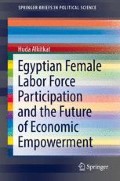Abstract
In accordance with the United Nations’ agenda for 2030 for sustainable development, namely the fifth goal: “Achieve gender equality and empower all women and girls” (United Nations 2015). It is important to plan for the future of women’s economic empowerment for females in Egypt. The expected number of females in labor force and the participation in the economic life in 2030 is one of the main important basics to produce plans and strategies for women’s economic empowerment.
Access this chapter
Tax calculation will be finalised at checkout
Purchases are for personal use only
Notes
- 1.
Egypt demographic and health survey is conducted regularly each 4/5 years on a sample of ever married women age 15–49. The main purpose of the EDHS is to provide detailed information on fertility, family planning, infant and child mortality, maternal and child health and nutrition.
References
Central Agency for Public Mobilization and Statistics. (1988). “1986 Census for Population and Houses”.
Central Agency for Public Mobilization and Statistics. (1998). “1996 Census for Population and Houses”.
Central Agency for Public Mobilization and Statistics. (2008). “2006 Census for Population and Houses”.
Central Agency for Public Mobilization and Statistics. (2015). “Annual Bulletin for Labor force Sample Survey, 2014”.
Nassar.H, et al. (2006). “Policy implication of the demographic dividend (window of opportunity) and its consequences on the labor market . a case study of Egypt” EPDI.
United Nations. (2015). Transforming our world: The 2030 Agenda for Sustainable Development. Resolution adopted by the General Assembly on 25 September 2015.
Author information
Authors and Affiliations
Rights and permissions
Copyright information
© 2018 The Author(s)
About this chapter
Cite this chapter
Alkitkat, H. (2018). Future of Egyptian Female Participation in Labor Force. In: Egyptian Female Labor Force Participation and the Future of Economic Empowerment . SpringerBriefs in Political Science. Springer, Cham. https://doi.org/10.1007/978-3-319-59644-0_4
Download citation
DOI: https://doi.org/10.1007/978-3-319-59644-0_4
Published:
Publisher Name: Springer, Cham
Print ISBN: 978-3-319-59643-3
Online ISBN: 978-3-319-59644-0
eBook Packages: Political Science and International StudiesPolitical Science and International Studies (R0)

